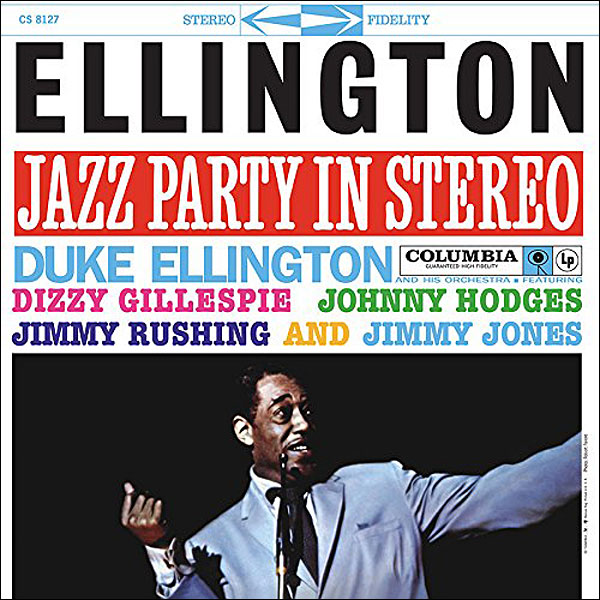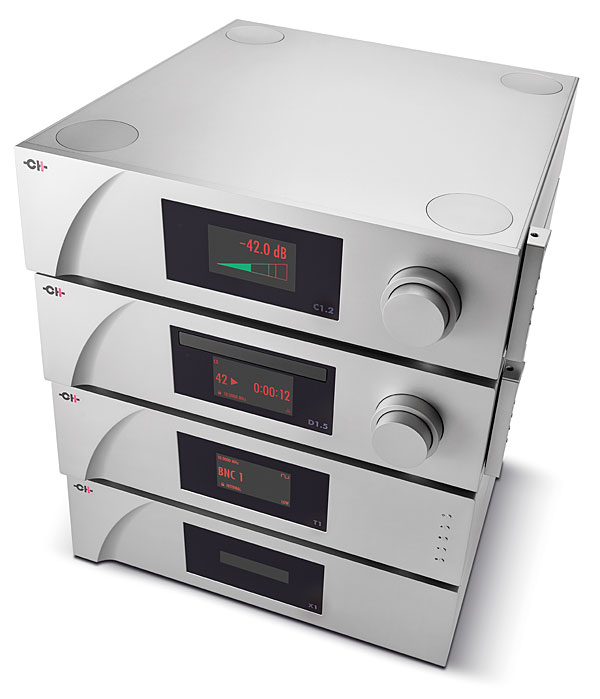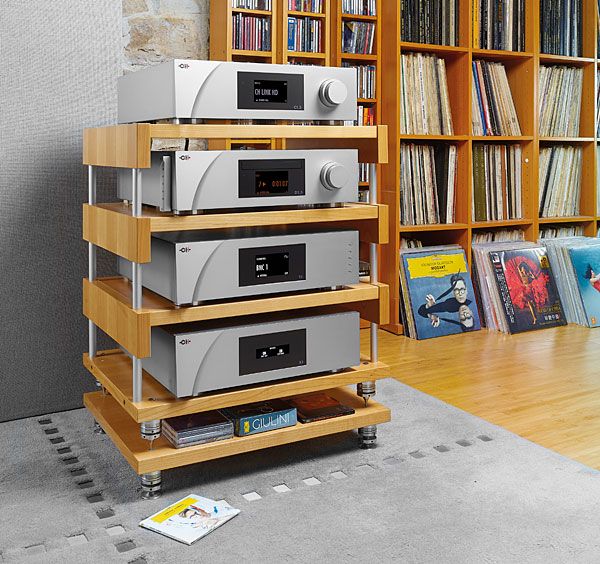| Columns Retired Columns & Blogs |
After the first page, the review image is, shall we say, rather blurred...
One very visible change in the C1.2 is the introduction of MQA support, which was not present in the C1. The C1.2 supports full decoding—unfolding and rendering—to frequencies up to 768kHz, including data from MQA-CDs played back on the D1.5 transport over the proprietary CH interface as well as MQA data streamed from Tidal.
I asked the two engineers how MQA is handled in the C1.2—with an off-the-shelf chip, perhaps? Not hardly. The C1.2 detects whether a datastream is MQA or not then sends it in one of two directions, toward the MQA algorithm (MQA data) or toward the PEtER upsampling algorithm (everything else). MQA data is interpreted in silico using a software library provided by MQA.
Maybe the biggest news with the C1.2 is a new MEMS (micro-electromechanical systems)–based clock, which is shunt-regulated (roughly, designed so that noise is shunted to ground) and temperature-compensated for improved accuracy.
Processing power has increased by a factor of four. The most obvious impact of this change is on the expanded range of input formats supported; the C1.2 now supports all of them, from a file or silver disc. The more significant impact of this increased computational power is more precise upsampling calculations. That's possible in part because the computational space has been expanded to 32 bits fixed-point (not floating).
It has become clear over time that one key to achieving the best possible digital sound is to keep the signal path free of noise. So—this is new also—the C1.2 turns off all processing channels that aren't currently in use, in order to lower system noise.
What else has changed? That hybrid analog/digital volume control has changed—but I'm not clear on whether it's completely new or just tweaked. Also, the display screen is better, although you won't notice it at first. It's capable of higher resolution than what you see most of the time. It's still not a thing you'd watch a movie on, but it looks pretty spiffy when you put the C1.2 in preamp mode and change the volume.
The C1.2 is modular, and when you consider all the options, remarkably flexible. It can utilize any common digital input, including Ethernet, plus CH Precision's proprietary data link, which resembles I2S and supports data-transmission rates up to the highest rates you'll commonly see. With the analog input card, you get two sets of analog inputs. Since it has a very good volume control, you could make it the central component of your audio system.
Listening
What do we look for—rather, listen for—in a digital music source? Or, for that matter, any audio source, or any audio system? "Tastes vary" may be the most important answer to that question, but I hope there are values we can all agree on: rich timbres and textures, vivid colors, images that seem solid and real, commanding bass, airy highs. Some will insist more than others that the sounds our systems produce be true to the source, although that can be hard to determine. (Loudspeaker designers, a suggestion: Don't release a high-end speaker that can't accurately reproduce common piano, like the sound of a Steinway Model D in a good hall. I hear a few loudspeakers that can't do that at every audio show I attend.)
Recently, over lunch with a small group of Stereophile writers, I shared my belief that one crucial thing in experiencing reproduced audio is a constant sense of surprise. Heads nodded. When a hi-fi system does harm to the music, it often takes the form of homogenization, making sounds seem more similar to each other, hence more ignorable and less surprising. Dynamic compression, for example, reduces contrast between loud and soft sounds, which tends to make music less surprising (especially with so-called microdynamics) and so, less real (footnote 10). Homogenization of every kind makes music less interesting and puts us to sleep. In contrast, a constant stream of pleasant surprises, which come through when the uniqueness of every sound is preserved, makes us look up and smile with delight at the music even when we're not paying close attention. That's a big part of what keeps me coming back.
There's another thing, though, that tends to come up in conversations about digital sources: a sense of relaxation in the music, whether the music encourages or at least allows relaxation in the listener—or whether, conversely, it is itself a source of stress. Digitally reproduced music can be stress-inducing. (So, in a different way, can scratchy old LPs.)
It's a peculiar idea: that something so important in hi-fi, some of the most important stuff, is something we experience in some unknown way but don't directly, or consciously, hear. How else to explain bass that (as I wrote in my review of the CH Precision D1.5 transport/player) sounds "fundamental" (in the sense of the root word "fundament") and "seismic," when we all know the LF frequency response will measure the same? So it's not the intensity or depth of the bass response I'm hearing per se; rather, it's how I experience it—and something in the music causes that.
When Heeb, Cossy, and the C1.2 documentation talk about the importance of precision in upsampling calculations or of reducing timing errors, they're not saying that if we don't do those things we'll end up with awful jitter, gross errors that affect measured frequency response, or that transients will be dulled or artificially sharpened (although our perceptions of all those things may be altered). In executing their design brief, they are indeed producing a more accurate signal, but the most important subjective consequences are—let's say, indirect. The specific mechanism is unknown, at least to me, but when you get it right, you hear it. They're gaining something, but they're also getting rid of something that, when it's present, stands in the way of our ability to perceive music simply and directly, with low stress and nothing interfering. (Then again, I think much that we call distortion, measurable or not, is like that.)

Remember Grosvenor's B-minor sonata, which I started listening to earlier? After it ended, Roon Radio started up Khatia Buniatishvili's 2011 recording of the Mephisto Waltz No.1, also by Liszt. The sound got better—it's a much livelier recording. I'm listening to just two speakers, sitting 11' in front of me, but the sound is enveloping me in a way that the Grosvenor recording didn't, especially in the louder passages. That sense of piano-case overload I mentioned is absent from this recording. The perspective here is more distant than on the Grosvenor recording, yet I can clearly hear a difference in soundstage depth between the piano's high notes and low notes, sounds emerging where the hammer hits the strings—rather, where those sounds reflect off the piano's open lid. I'd say I'm sitting in row 20 or so—that's the aural perspective—so the piano is pretty far away, but the effect is very clear. And even the loudest sounds seem relaxed, stress-free.

Speaking of Buniatishvili: Not only does she make wonderful recordings of great music beautifully played; she also chooses superbly interesting repertoire. The next-to-last track on her album Labyrinth, from 2020 (24/96 FLAC, Sony Classical/Qobuz), is John Cage's 4'33". I won't say it's her best performance, but it's certainly her most perfect, the one with the fewest mistakes.
Over the last few months, I've listened to a lot of classical music, naturalistically recorded in a real space. (Is that choice of music affected by my current DAC? I wonder.) With such recordings, what I hear with the C1.2 is what acoustical instruments sound like, precisely rendered in space. The sense of that space, and of the sounds flowing through it, is expansive and relaxed; that expansiveness and sense of relaxation are somehow connected. Except when the pressures of getting the magazine out the door interfere with my state of mind, I am relaxed while listening.

In this issue, Jason Victor Serinus reviews Caroline Shaw's recording The Wheel (24/192 wave download, Alpha), with the French collective I Giardini; it's Stereophile's Recording of the Month. It's my Recording of the Month, too.
One track Jason didn't mention in his review is the second, "Gustav Le Gray," which, for its first half or so, is identical to—indeed, is—Chopin's Mazurka Op.17 No.4. After the halfway point, the mazurka comes unglued. "Gustave Le Gray," Shaw writes in the liner notes, "is a multi-layered portrait of Op.17 #4 using some of Chopin's ingredients overlaid and hinged together with my own." Fascinating stuff. Through the C1.2 DAC, it—especially the piano, which is what I focused on the most—simply sounded right.
Just now, I needed a break from writing, and my six-month-old puppy Ella (who is responsible for this lightly chewed listening chair I'm sitting in) needed a break from not peeing, so we headed outside then south on Riverside Drive. At last night's dinner, a guest had mentioned Duke Ellington Blvd., also known as W. 106th St. My wife's grandparents lived there for a long time, on the northwest corner with Riverside Drive. Their apartment building was across from a beaux-arts mansion, which some—including one of my dinner guests—have said Duke Ellington lived in for a while. He didn't (footnote 11); he lived around the corner at a more modest address (331 Riverside, it is said). But when we both needed a break, I put Ella, the new puppy, on a leash, and we headed toward 106th Street.

All this put me in mind of the Duke, so when we got back, I put on one of my favorite albums—an unusual one for Duke—Jazz Party in Stereo (footnote 12). I usually listen to this record—this album—on vinyl. How would Jazz Party in Stereo, which is such a natural on vinyl, with its spacious soundstage, full of all sorts of percussive sounds, from timpani (aka kettledrum) to triangle, sound through fancy digital gear?
This is a ping-pong-y album. All those percussive sounds distributed across the soundstage, left to right and front to back, make a spectacular impression. Immediately, though, I noticed a lighter, smoother character to this highly percussive album, not in a good way. Is digital really this much worse than analog, even through a $43,000 DAC? And then I realized I was listening to a DSD file I bought some years ago (DSD64, Columbia). I know some people love it, but I have often found DSD to sound unnaturally smooth—it's one of those homogenizing influences I mentioned earlier.
I switched to the MQA version, streaming (16/44.1 MQA/Tidal). The C1.2's front panel display turned green, indicating MQA Studio. This version was louder than the DSD version, so I turned it down a bit, matching levels by ear but only roughly. Restarting the track, I immediately noticed more grunt and heft in the drums, more sharpness—even harshness—in the high percussion (xylophone, vibraphones, glockenspiel, tambourine, triangle). At first, Jimmy Woode's bass sounded like it could be a kettledrum or some other percussion instrument, but over time its "pluck" emerged. Britt Woodman's trombone had real, blatty flesh. Duke's piano sound was very natural—one of the better-recorded jazz pianos I can remember from this era.
This is what this album sounds like. It's what the record—the LP—sounds like. I'd probably still put the vinyl on on a celebratory Friday night, but this sounds just as good, or—it pains me to say it—perhaps better. I'm listening at 10am on a Sunday morning, feeling exhilarated, nothing between me and the music (footnote 13). Time to whip up a cocktail? It's 5 o'clock somewhere.

The CH Precision digital stack
This is a review of the C1.2 DAC, but I was privileged to hear that instrument in the context of the full CH Precision digital front-end, with the D1.5 transport, X1 power supply, and T1 clock. How much difference did all the fixins make?
Some difference, for sure, but I didn't find them necessary. As editor of Stereophile, I suppose I should be an absolute perfectionist, but the fact is, I have limits. Not infrequently, I hear sound that's totally satisfying, that I could happily, joyously, live with forever. I'm getting that with just the one box, the C1.2.
Sure, if money (and, importantly, space) were no object, I'd buy them all. I say "pretty sure" because money and space are indeed objects, so I can't really put myself in that position; I can only pretend.
In my review of the D1.5, using it as a player, digital conversions carried out by its dual-mono DAC boards, I found—this surprised me—the external clock made a big, meaningful difference. I did not find that to be the case this time, with the C1.2. I heard differences, subtle and difficult to describe, but none that substantially increased or decreased my pleasure in listening. The X1 power supply made a bit more difference, adding, I thought, a touch more flesh, more tangibility, to acoustic objects, but I could live without that, too. Call me easy to please, but I'm willing to settle for just the $38,500 version (with the options I'd need installed)—although I'd also be tempted to include the analog input board for another $2500. I guess a $40,000 DAC—this $40,000 DAC—is good enough for me. So sue me.
If I were to buy both the D1.5 and the C1.2—and if money were no object, I would buy both, because it's nice to have the ability to play discs—I would add the T1 clock. And the power supply? Compared to the other components, it's pretty affordable. Might as well throw that in, too. If money were no object.

Summing up
I have little to add. There are other digital sources in this price class, from the three-letter companies, dCS and MSB. There undoubtedly are others in a similar price class—and one manufacturer at least is charging more. But I haven't heard any of those other sources in my system, so there's no way I can compare.
If there's a downside, it's the price. It would be cool if it cost a tenth as much, but then it would also be cool if I could fly. As I've often said and occasionally written, value is a question of values—and also of wealth. If you're richer than me, I'm okay with that. It's a decision each of us must make on our own.
The C1.2, both with and without its external clock and power supply, produced the best sound I've heard from a digital source—far better than far cheaper chip DACs that we've put in Class A+ on our list of Recommended Components. Which is a problem for Stereophile's editor: Do we need to create a class A++? The CH Precision C1.2 gives new meaning to "turn it up to 11!"
Footnote 11: The mansion does have a musical history though, sort of. Back in the 1980s and '90s, when my wife and I were visiting her grandparents in the apartment across the street, it was known as the Seagram building because Seagram heir Edgar Bronfman Jr. lived there. Bronfman would soon become Seagram's CEO and sell off valuable assets to make big bets in the music industry just as illegal file sharing was starting to shred it. He would go on to be CEO and chairman of the Warner Music Group and do a skillful job keeping the company afloat during some of its worst years.
Footnote 12: There's a mono version, which is called just Jazz Party. Straight from the liner notes: "As the crowd gathered, Duke was on the phone calling his group of nine percussionists, and the studio lobby was filling up with kettle drums and xylophones. Chairs were set up for our unexpected audience, and Duke, with the innocent expression of a small boy who has just dropped a match into a gas tank, said, "Let's see what happens."
Footnote 13: No, I'm not listening naked. That's not what I meant.

After the first page, the review image is, shall we say, rather blurred...

"Not just any DAC chip, but one that was an important step forward for digital audio when introduced—in 1998. It is Burr-Brown PCM1704 R-2R ladder DAC chip, four per channel. Why do it this way"
Have a listen to an old Naim CD555 to hear how good R2R ladder can sound.
The R2R PCM1704 was a killer converter chip. (just got too expensive to produce, having to laser trim all the minute R2R resistors Barrie Gilbert (AD) told me) Delta Sigma conversion good for DSD, ESS, Wolfson etc etc, doesn't have this laser resistor trimming problem, then they don't sound as good converting PCM 16 or 24 bit recordings either, they can only do a "facsimile" of it, where R2R ladders convert PCM "Bit Perfect"
If they were easy to get, even the discrete R2R dac manufacturers would use them. The "potential" (depending on the design) for far better specs are always there for a far smaller package of the same thing.
Cheers George

The question is, is an 80K+ Dac (with power supply and clock) also 8 times (800%) better than a 10K Dac (with everything integrated) or still only 0.2 (20%) better or still only 0.1 ( 10%) or even just 0.05 (5%). "The best sound I've heard" ... yes, I believe that ... but how much in proportion? That's not what the review says. Better but how much better? Let's say audibly better and yet really 0.2 (20%) (which seems a lot to me, but okay) for an 8 times (800%) more expensive. Is that proportional? The answer is of course subjective. And for many here, even a 10K is way beyond the available budget. Always nice to read about the Bugatti Chiron while driving an Audi A1, or looking for it and so to speak.

And if you listen with trained ears through topnotch audio systems well set up, it's frankly hard to miss the improvement in sound achieved by expensive DACs produced by companies committed to achieving the best possible digital sound.
Jim, hard to miss how? And why has no one anywhere ever been able to demonstrate this? Perhaps you can show us the way.

...but your remark prompts a tangential question anyway: Would you like to tell me what I hear?
See, the Editor already included the answer to your question. He heard the sound of it. I'm not sure how else it would manifest if not through hearing, that being the point.
From that I think it's fair to ask if you missed that or if you're alluding to denying another listener their impressions. Hence, would you like to tell anyone else what they hear too.
Would you then expect someone to somehow demonstrate these things to you? How? By what means? And who are you or I that it matters when you effectively admit you cannot or will not hear it anyway? What proxy is this you propose that not hearing a thing, you are interested in a demonstration of its presence anyway?
The biggest problem with the objectivist line is that taken to its conclusion it's a tacit admission that s/he's not capable of hearing a thing. At which point then why bother with better audio at all?

Not being able to admit one hears great musical presentation when listening through a $1M system at an audio show remains the last vestige of proof objectivists willingly deny.
Many have walked out of MQA demos without listening to 1 minute of music before reaching their summary judgment.
They are a literally 'not bothering with better audio' at all. They are the very definition of fool.
Some patience and willingness to hear the difference, in spite of their theoretical dogma, is the key.

...argue online about anything and given anonymity, do so with reckless abandon. Audio is no exception. With this in mind it's no leap to predict they'll make meaningless noise about things they've never heard, don't understand, couldn't technically comprehend, and deny others the effect of.
I hope writers and readers realize the pop-objectivity movement only purports to have scientific interest. They're malcontents. They're actually coming for your enjoyment.

Is that many are unwilling to set up an unsighted test, because they will find out that they don't have golden ears and can't hear many of the differences they claim to hear.
Doesn't mean no one can; just means many make the false assumption that they can. They don't want to face the reality that they can't.

... no subjectivist line. I hear. The problem is the incivility and intolerance you harbor because I do.
I also don't need an unsighted test. Again, I hear. In effect I "set up" an unsighted test every time I plug something in, almost always finding that what I thought it would do it won't. It goes and does what it actually is because it is. I allow for that and I enjoy that. There I learn; I learn because I'm a scientist and not what you'd like to think I am, your complete stranger.
That's the difference. That's the intellectual asymmetry. This drives you nuts and your recourse is to lash out. You're postmodern audio-woke. You despise that classical structure and you've invented a new pseudo-ethical system you wish you controlled.
So. You're projecting and further, you're doing it among your superiors, not the degenerates you seem to think number these subjectivists you think you're on about. For your dysfunction to work in your mind you have to invent adversaries that don't exist. So you do and here we are.
Your formulation is logically incomprehensible and I suspect you'll deny it forever.

Total nonsense.
One, where did I lash out? I think reading posts, it's obvious who's projecting and who's inventing adversaries. It isn't me.
And the fake intellectual approach is just you hiding ad hominem arguments behind sophisticated language instead of discussing.
All I wrote was most audiophiles don't actually test themselves and find out if they can really hear differences. There's no illogic there. It's a fact. How many audiophiles have ever actually taken a listening skills test like the Harman one to see how golden their ears are?
Most ignore the role expectation bias plays in human perception.
A good scientist would acknowledge all of that and deal with it instead of pretending it doesn't exist and exaggerating his abilities.

...that you have an opinion.
What I have is a demand: Where's the statistical proof that seeing a big walnut box alters the way it sounds versus a small black one. Or a shiny amplifier versus a utility enclosure. Or a fat cable versus lamp cord.
Isn't that your sighted bias canard in a nutshell? Then for it not to be a canard I expect tables of cited evidence of these sighted biases and not the usual driveby youtoob mcgurks.
Where's your statistical proof a commercial for-profit organization has captured the essence of all natural auditory phenomenona per all recreated sound from all conceivable reproduction systems and has interpreted it strictly for that benefit and across all use cases?
Where's the statistical proof the unnatural structure of your forced listening test is utterly transparent, not just technically but mentally, psychologically, and auditorily? Remembering your foregoing sighted bias, that is.
These are not rhetorical questions and I expect you to answer each of them with scientific rigueur and depth and references. You haven't. What you have done instead, not just throughout your work here but in this one comment alone, is
-Denied obvious reason;
-Expressed an assortment of frankly risible opinions based on generalities;
-Denied an obvious truth with unfounded, accusing opinion;
-Based on an assumption, issued a completely ambiguous demand;
-Denied it;
-Asserted an arbitrary standard (which I now demand you confirm per statistical proof that it speaks for all audio, all hearing, and all experience);
-Asserted another unmoored generality without evidence;
-Closed with doublespeak, rhetoric, and an uninformed lie, accusing your interlocutor himself of lying.
You're excellent at open opinion, DH, and frankly you're very good at the character defect so many of us have seen for so long among your kind. Now let's see your body of research supporting a more factual basis.

Try checking the Harman research on sighted listening bias.
Or the massive amounts of studies on all types of human perception, including audio perception that show expectation bias. It's really not hard to find.
Not long ago it was shown that humans even hear different volume levels (where none exist) and that the perceived volume level changes according to the color of the volume knob they are presented with. Just one of many examples.
It's massive and undeniable, except by people like you who refuse to see if their listening skills actually stand up to scrutiny.
My position (that not everyone has golden ears and that expectation bias in listening exists) is backed by science. Are SOME people skilled listeners and able to hear small differences? Yes. But a minority. And certainly not all those who ASSUME they are.
You are the one taking an extreme position - that both of those ideas mentioned above are false, and that you and other audiophiles all have golden ears and are immune the the basic workings of the human mind.
My position is backed by science. Yours is backed by ego and wishful thinking.
The onus is on you to prove your a-scientific assertation.

...Google it. Like one of the local writers said to a fellow traveler in another thread recently, that's a system of belief:
Do you have research to back up your assertion, David? ... Because, if not, it's simply your belief.
To which I'll add, now you admit it's a belief; that neither he or you or anyone else can begin to mind-read the subjects or even conceive of the technical granularity needed to validate the claim, the belief. You invoke science in a decidedly unscientific, even anti-scientific rhetorical ploy, and you further admit no acuity or appreciation for the ways and means of the people you troll, scientific or otherwise.
Again quoting Jason:
As I learned a long time ago from my cursory exposure to A Course in Miracles, there is nothing to defend. What there "is" to do is pay very particular attention to set-up, upgrade my system to make it a fine tool for discerning differences large and small, listen closely, and write with integrity and dedication to what I perceive to be the best interests of readers of Stereophile.
Bravo. As it should be. And those best interests are reciprocal, DH.
None of this was a mystery before and with each passing comment you drive that point home. "Google it. Because science and commercial interest." And any extrapolation of this basis in your purported body of objective fact shall not and may not apply, while any expectation it apply will be not just refused but baldly denied.
Like I just said, driveby mcgurk the thing anyway. Because science. But really because you really can't get to the granularity needed, can you, and you can't imagine what it might be. You're left with, as you just did again, projecting a coarse generality borne by a meager, unqualified belief about physical systems, systems you didn't engineer and systems you, evidently, cannot hear.
And that, DH, is actually the very core of anti-science. That is your impediment to discovery.

Great review. Actually, the best review of anything I've read regardless of the topic. Engaging, factual, informative, fun with the added spicy of honesties. The very best review I've ever read. Kudos, Jim Austin!

Hi Jim,
Your question, "What, then, is the point in paying tens of thousands of dollars for a D/A converter?" resonated with me. I had been very happy for several years with my BorderPatrol DAC (I know it caused some controversy in these pages). When shopping for a DAC, it clearly offered, to my ears, the best sound quality to cost tradeoff in my price range. Then last year I was at my local hi-fi shop where I heard a system similar to mine playing through a Chord Dave (about 10 times the price of the BoarderPatrol DAC). It ruined me. It was better in all ways that matter to me. So, I guess case in point. Thanks.
--Monty

"What, then, is the point in paying tens of thousands of dollars for a D/A converter?"
My first post, if designed right it "could" compete or even better the MSB R2R Ladder Discrete dac, similar pricing.
Not to mention trying to get the PCM1704k dac chips, as they are as rare as rocking horse **** to find, and big $$$$$ if you do.
Cheers George

Since when did frequency and time-domain performance exist as separate dimensions rather than intercorrelated in digital sampling?
Since when did we accept this as true?
"Time smearing is basically if you put a single pulse through the system, if you have a filter with a very long impulse response, that single sample will extend over a large number of samples."
That shorter impulse response has anything to do with improved sound quality because "time smearing" is supposedly better!?
Some of the best time-domain performance comes from designs like the Chord DACs. I agree with MontyM that a Chord DAVE is superior to his BorderPatrol (but no need to think this is about the price of the device!). Look at the impulse response of those Chord devices - and corresponding frequency response.
A long impulse response is not a measure of problematic audio "smearing". It's just a reflection of the device's filter when fed a poorly or non-low-passed signal like that single-sample "unit impulse".
Subjectivists like to believe that "measurements don't matter". So why believe the impulse response correlates to anything that subjective-leaning audiophiles should look at and think makes a difference?!
I'm sure the CH DAC sounds fine; although clearly the measurements show limitations like linearity of the old DAC PCM1704, and right-left variations as JA noted. Worth thinking about given the asking price.

...subjectivists that believe that "measurements don't matter". Rather they believe that measurements have not captured either the magnitude or ranked importance of all audible phenomena. This is because they hear; they do audio for the experience and find that data must serve that end.
There is copious evidence, including in regular drive-by remarks in these threads from the ASR swamp, that Objectivists like to believe that measurements are all that matter, notwithstanding that those measurements are meaningfully incomplete. This is because they do not listen; they do audio as a cancel culture and also find that data must serve that end.

"...would you still need to smoke a cigarette?" No. I would take two aspirins instead.
"And does this equate good comments with sex?" Let's just say that the best comments can give me a spontaneously rapturous release.

Reading thi review I have the sensation that the Stonehenge layout reveals the secrets of Betelgeuse.

Archimago: "I'm sure the CH DAC sounds fine; although clearly the measurements show limitations like linearity of the old DAC PCM1704, and right-left variations as JA noted."
That's just implementation, not the fault of the PCM1704-K dac chip itself, as shown here with JA doing the same measurement on the Mark Levison 30.6 which also uses 4 x PCM1704-K chips.
JA: "With its superb linearity and low noise floor, it comes as no surprise that the '30.6's reproduction of an undithered 1kHz tone at -90.31dBFS is essentially perfect."
Cheers George

The very expensive DACs may sound a little better.
I contend that the vast majority of audiophiles won't be able to tell 2 very good DACs apart in an unsighted test.
Most don't have golden ears - they just like to tell themselves they do, and never test themselves to find out if they actually do. They often rely on imagined differences brought about by expectation bias.

...set of projections, if by interesting we mean boring as hell. Would you like each fallacy of your contention exploded in order or as a lump sum?

Don't need your "help". And no fallacies involved. I've seen it happen multiple times. Audiophiles are sure they know which amp is which, until they listen unsighted. Then they can't tell and those obvious differences suddenly aren't.
Doesn't mean the reviewer or some people can't hear the difference between this DAC and a $1000 Chinese one. But it means lots of readers of this publication, some of whom are very sure they can, can't.

...probably don't want help evaporating that abject mythology. That's not a mystery; it never was, and I appreciate your saving us even more time.
I recommend continuity: Reduce all your exploits in great sound to more of the same artificiality that makes everything sound equally forced and distilled. Go AB some chifi. Use one recording, take 15 second snippets, keep score, and always involve agreeable minds. Music is to be a miserable, smug competition. Then make ambiguous references to these vague fields full of your imagined projections of the shortfalls of others that you'll personally never suffer from because you're you. You advance fine audio by leaps and bounds by the day.

Your smugness and arrogant prove nothing about your supposed point, but lots about you.

At 44.1kHz, we think we can hear filter artifacts. Maybe. On certain program.
At 96kHz original program, the artifacts are gone. We hear no filtering issues, regardless of program.
Technique doesn't matter. "Splines" don't matter. All of this seems 100% related to magnitude response over time.
The $1M question becomes: On a 44.1 signal, is it less harmful to do a high quality up-SRC before filtering? Or avoid SRC and filter at native 44.1?
In our experience, and apparently in the experience of CH, Weiss, and others, using a pristine SRC to 192 or 384 (etc) is the better approach. SRC to 96 is probably just fine, as well.
Is any of this deeply unique engineering? Naw. Simple stuff, really.